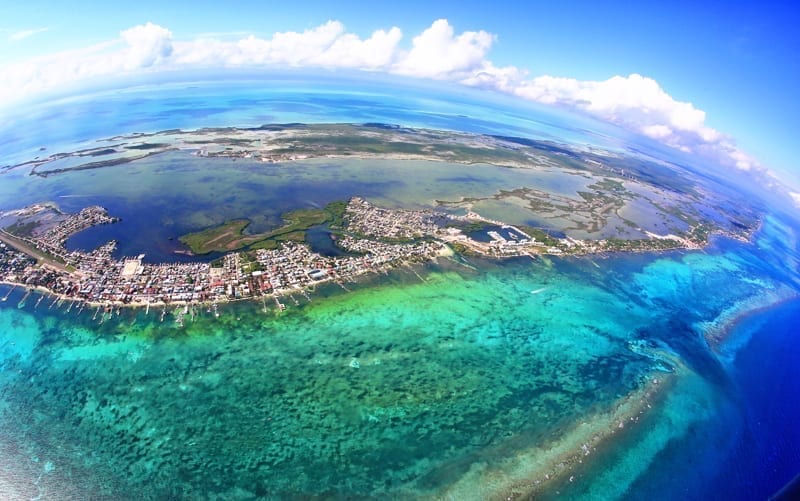When the first Western-born sailors reached the island in 1508, they were greeted by an estimated 10,000 Maya inhabitants living all over the island, which was still ruled remotely by the strong but declining empire of Chetumal to the north. These island Maya lacked the resources and population to build the giant temples and tombs you see elsewhere in Belize, but were an industrious and prosperous people, nonetheless.
Much of the wealth of this generation of Ambergris Mayas came from trading with the Maya from Chetumal and with the Maya of what now is mainland Belize, this trade due to their ideal location at the center of these different populations. Fishing would have been an important part of their trade goods at the time.
The trading position and strategic advantage of Ambergris was of such importance at the time that the early inhabitants dug a canal across the northern part of the island in order to connect the interior lagoon of the peninsula to the Atlantic Ocean.
This channel allowed for easier access to the best fishing grounds and direct outlet to the trading routes. And, most significantly, changed Ambergris from being just the southernmost peninsula on the Yucatán into an island in its own right.
The channel has eroded naturally over the centuries and has been continually dug out by following generations. Thought to be only a few feet wide originally, nowadays it’s much larger; the area surrounding the canal is known as Bacalar Chico National Park and Marine Reserve, founded in 1996.
The newly arrived European sailors were impressed at the abundance of farmed and fished food the Maya had reaped from the fecund island, including domesticated turkeys, corn, tobacco, cacao, cotton, and many vegetables.
Pirates!

Over the next century, European pirates began to ply their trade from mainland Belize and Ambergris. These bands of fortune hunters used to foray out through the small splits in the barrier reef (called quebradas) to attack the Spanish fleets—which often consisted of much larger ships—then would retreat behind the reef’s solid protection to escape reprisals.
The shallow draft inside the reef prevented bigger Navy ships from following and capturing them. Legend has it that these pirates eventually dredged out the channel at Bacalar Chico to allow easier escape and access to secret places on the mainland to hide their spoils.
The entrepreneurial pirates took to whaling to supplement their incomes, and the island eventually took the name of the most prized part of the sperm whale, a substance that washed up on the caye’s beaches from time to time: Ambergris.
The British

A group of British businessmen formed the Belize Agricultural Company and bought Ambergris Caye from the crown in the hopes of reaping profits. It’s said they attempted to grow sea island cotton, the finest cotton in the world, among other crops, but the efforts flagged and eventually failed. By 1842 the island was sold again, this time to a Mr. Welsh and a Mr. Golf.
From 1848 to 1849 the Caste Wars in the Yucatán (Mexico) drove indigenous and mestizo (those of mixed Maya and Spanish ancestry) refugees south into Belize. The British allowed about 50 families of these migrants to settle on Ambergris Caye with those few indigenous peoples left on the island, in the hope that these farming-minded peoples would help feed the lumber crews harvesting wood on the mainland. From these settlements, the village of San Pedro was born.
Industry

In 1869, the island was purchased by an English magistrate, Mr. James Humes Blake, for the incredible sum of US$625, and very soon the island became the center of a growing coconut plantation industry.
Logwood was also continually harvested on the island until synthetic dyes destroyed the demand for such hard-to-extract natural dyes; by 1910 the logwood industry was dead.
Workers were also hired to work the in the chicle industry, bleeding sapodilla trees for their sap, which was eventually boiled down to make chewing gum. This industry also collapsed in the 1930s.
Coconuts were then the main industry on the island until a series of hurricanes between 1942 and 1955 devastated the plantations.
During this time the settlers—tenant workers now that the island was owned by the Blakes—fished, farmed, and worked the plantations on the island.
It was also around this time that the lobster industry was beginning to take off. Labor for the coconut plantations became scarce, so Ambergris took on other industry as its mainstay. Funnily, lobster was not valued as a commodity on the island, historically. In the 1920s it wasn’t valued at all… In fact, there is still a law in Belize that forbids the feeding of lobster to prisoners more than twice a week!
During the 1950s the price of lobster was 1 cent per pound, but slowly the demand increased until a cooperative was founded in 1963 for the betterment of the fishermen and to secure proper prices for their catch. Soon conch and other fish were being exported in addition to lobster and the Belize fishing industry began to flourish.
When the Peoples United Party of Belize achieved self-governance for Belize in 1964, they purchased land from the decedents of the Blake family and sold it to local workers, allowing them real tenure of their island for the first time.
Soon enough, though, it became evident that there was now more money to be made on Ambergris in the real estate speculation business than in fishing.
The 1980s saw the heyday and downfall of the fishing industry in Belize. In 1984 San Pedro was given its status as a town and by the early 1990s tourism started to eclipse fishing as the dominant industry.
The Economy And People Today

Today, tourism is the mainstay of the island, as is any commercial activity related to water… be it boating, diving, fishing, surfing, or anything else you can imagine on or near the water.
The embarrassment of natural riches Belize enjoys makes scuba diving and snorkeling in the many marine reserves a spectacular and globally-sought experience. The Blue Hole, for example, is a collapsed underwater cave and a once-in-a-lifetime dive or snorkel experience that should be had by anyone with even a vague interest in diving. The Hol Chan Marine Reserve Park is likewise a diver’s paradise, and Bacalar Chico is a UNESCO World Heritage Site you can enjoy from above and below the water. People travel from all over the globe to dive at these unique sites.
And many more come for sport fishing beyond the reef, or to take catamaran rides, or to simply boat around the shores. These water sports and their related tourism is a major industry for the modern island.
Con Murphy
Belize Insider











